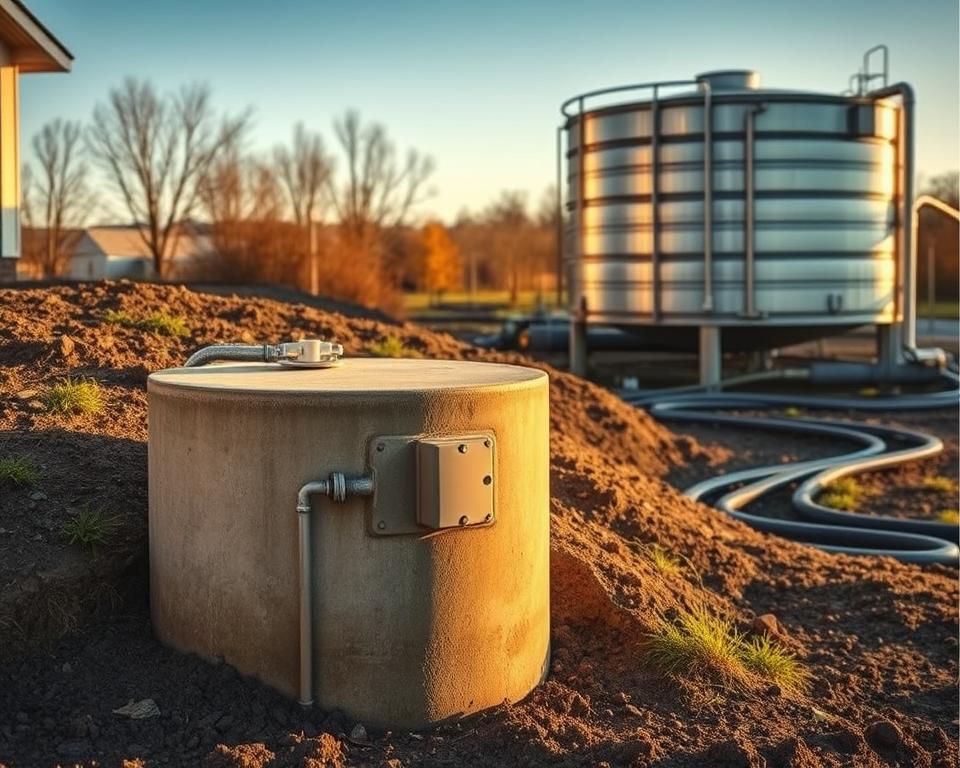Septic Pumping Cost Guide – Essential Info for Homeowners
Did you ever wonder the true expense of overlooking your septic system? Being a homeowner with a septic system means you should appreciate the importance of regular maintenance. Knowing the expenses of septic pumping and what affects those prices is vital. Such insight can avoid a blockage and the foul smells that come with it. We aim to inform homeowners on septic pumping’s value, pushing for proactive upkeep for a healthy home environment.
Essential Conclusions
- Septic systems are vital for homes without municipal sewer connections.
- Routine maintenance can save homeowners from costly repairs.
- Septic pumping fees differs based on various factors.
- Grasping septic tank pumping prices is critical for budgeting.
- Preventive septic system maintenance promotes longevity and efficiency.
What is Septic Pumping?
Septic pumping clears out waste and sludge from a septic tank, essential for system efficiency. Over the years, solids collect at the tank’s bottom, making it necessary. This procedure prevents overflows and malfunctions. Understanding septic pumping underscores its maintenance importance, hence septic system service.
Keeping a septic tank in prime condition calls for regular maintenance, including pumping. Typically, a tank requires attention every 3 to 5 years. Factors like tank size and household usage dictate this schedule. Proper maintenance removes blockages and extends your system’s lifespan, helping avoid expensive future repairs.
Variables Impacting Septic Pumping Cost
The cost of septic service fluctuates considerably, primarily influenced by the tank’s size. Larger tanks need more effort and resources for pumping, so they are more expensive. Additionally, your geographical area plays a significant role in determining costs. Prices in cities are higher due to the increased costs of labor and transport, whereas country regions might be cheaper.
The regularity of septic pumping is another essential factor, influenced by the household size and water usage. More occupants or higher usage implies pumps are needed more often, driving up the costs. Also, any supplementary services required during pumping, like inspections or repairs, can hike up the bill substantially.
Maintaining your septic system is crucial to prevent emergency repairs, which are costly. Scheduled maintenance not only reduces costs but also helps ensure your system remains efficient.
Typical Septic Pumping Prices
The cost to pump a septic tank is usually $250 and $600. Most homeowners will spend close to $400. The price is influenced by the tank’s size, its location, and how often it needs maintenance. These factors enable families to forecast their budget for septic system upkeep.
| Tank Size (Gallons) | Average Pumping Cost ($) |
|---|---|
| 750 | 175 – 300 |
| 1,000 | 225 – 400 |
| 1,250 | 275 – 500 |
| 1,500 | 345 – 600 |
| 1,750 | 400 – 700 |
Remember, inspection costs might add by $100 to $250. Regular upkeep can minimize these expenses. It helps avoid the hefty fees associated with major repairs down the line.

Tank Size vs. Pumping Expense
The size of a septic tank significantly affects the overall pumping cost. For instance, tanks with a 750-gallon capacity usually cost between $175 and $300 to pump. By contrast, a 1,750-gallon tank’s pumping fees can range from $400 to $700. This demonstrates the septic tank size impact on cost, highlighting how capacity influences maintenance expenses.
Higher water usage by a household leads to more frequent pumping, thus increasing expenses. A large family using more water will need pumping services sooner than a smaller one. By using a septic tank pumping cost estimator, homeowners can better plan for these costs. This tool includes septic tank size and its maintenance needs.
| Septic Tank Size (Gallons) | Pumping Cost Range ($) | Estimated Frequency of Pumping (Years) |
|---|---|---|
| 750 | $175 – $300 | 3 – 5 |
| 1,000 | $300 – $400 | 3 – 5 |
| 1,500 | $350 – $600 | 4 – 6 |
| 1,750 | $400 – $700 | 4 – 7 |
Grasping how tank size affects costs helps owners in making educated decisions. It enables practical management of septic systems and maintenance planning.
Location-Based Pumping Costs
Septic pumping costs widely fluctuate across the United States. The variation is driven by local labor rates, service demand, and cost of living. In rural areas, pumping services may cost as low as $200. Meanwhile, in urban areas, prices can surge from $400 to more than $800.
For a useful overview, the table below shows average septic pumping costs in various cities:
| City | Average Cost ($) |
|---|---|
| Philadelphia, PA | 265 |
| Charlotte, NC | 889 |
| Los Angeles, CA | 650 |
| Chicago, IL | 450 |
| Austin, TX | 375 |
Recognizing the regional variances in septic tank pumping costs is crucial for homeowners. It provides the knowledge to make sound choices. By gettting to know local prices, homeowners can find the most appropriate service providers. This ensures their septic systems are correctly maintained.
Pumping Schedule Guidelines
Grasping the correct frequency for septic pumping is vital for a well-functioning system. The Environmental Protection Agency suggests most tanks require service every three to five years. This guideline differs based on the size of your household and your daily water use.
For smaller homes with 1 to 3 people, pumping every 4 to 6 years may be adequate. However, families of 6 to 10 should consider more frequent servicing, perhaps every 2 to 4 years. Planning your septic tank pumping properly improves its efficiency considerably.
Slow drainage or sudden sewage backups warn of impending pumping needs. Keeping a routine check-up, while following professional advice, supports the system robust. Such precautions prevent expensive repairs in the future.
Extra Septic Expenses
Careful budgeting is crucial for septic system upkeep due to numerous cost factors. Beyond standard pumping, you must consider other service fees that may come up during regular checks. Routine inspections are key for maintaining the system’s health, averaging around $300. These spot issues early, heading off major problems.
Unforeseen services can be quite costly. For example, removing a clog might cost up to $1,700. Such expenses greatly influence the maintenance budget. Additionally, field aeration, important for the system’s efficiency, can cost between $10,000 and $20,000. This constitutes a major investment in the system’s longevity.
Maintenance tasks like filter cleaning also entail varying costs, between $100 and $1,000. These expenses contribute to the overall budget for septic upkeep. Homeowners should plan ahead for these costs. Knowing these potential charges helps ensure your septic system operates efficiently.
Budget-Friendly Pumping Tips
Homeowners in search of cost-effective septic pumping solutions have a range of strategies at their disposal. One effective step is to request quotes from multiple providers. This reveals the going rates and identify attractive offers. Companies close by, like All in Sanitation, might extend benefits for local residents, potentially lowering costs.
Deciding to schedule maintenance during the less busy months can lead to substantial savings. It’s a good idea to look into bundling options, as they often come with special discounts. Monitoring for the latest promotions and available deals on septic services can substantially reduce the upkeep costs.
Importance of Hiring a Professional for Septic Pumping
Engaging a professional for septic pumping is crucial for safety and the system’s peak performance. These experts have advanced knowledge and the latest equipment for thorough septic care. Attempting to pump a septic tank without the right skills can put you in contact with dangerous methane gas.
Professional septic services ensure your system meets local waste disposal regulations. This compliance is important for public health and protecting the environment. With heightened environmental concerns, choosing licensed and experienced septic services is critical.
When scheduling maintenance, consider these key points:
- Expertise in handling different septic systems
- Access to proper equipment and technology
- Knowledge of local laws and regulations
- Ability to identify potential issues before they escalate
- Experience in efficient waste disposal methods
The Value of Routine Service
Consistent upkeep of septic systems is crucial to ward off high-priced repairs and failures. It helps that these systems function well over time. Without proper upkeep, serious issues like backups and leaks may occur, necessitating high-cost fixes.
Periodic inspections and adherence to pumping schedules dramatically extend septic systems’ longevity. This regular care not only minimizes the risk of wear but also supports eco-friendly living. Homeowners then gain the certainty that their systems are reliable, protecting both their financial investment and health.
Bringing It All Together
For homeowners relying on septic systems for waste management, understanding their upkeep is critical. Exploring the costs of septic pumping illuminates the financial aspect of system maintenance. By ensuring routine maintenance and scheduled pumping, expensive emergencies can be avoided, boosting the system’s longevity.
We examined the factors that affect pricing, looked at regional cost variations, and emphasized the necessity of maintenance. Applying these recommendations and seeking professional guidance allows homeowners better handle their septic systems. This guarantees safe and long-lasting functionality.
Beyond mere regulatory compliance, proactive care of your septic system improves your home’s health and protects the environment. By making educated decisions on maintenance, homeowners can ensure a seamless and worry-free experience.


